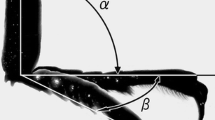Summary
The ultrastructure of the thread-like hairs (sensilla) on the tibia of the front leg ofAcheta domesticus (Gryllidae) Saltatoria was examined by serial sectioning. The presence of a tubular body indicates that these sensilla are mechanosensitive; electrophysiological measurements also confirmed this. The opposing forces on the articulating apparatus of single hairs and the sensitivity of the single receptor cell were measured after deflection of the hair in different directions. The articulating apparatus is characterized by three cuticular elements: a joint membrane, suspension fibers, and a socket septum. These elements form the basis for a structural bilateral symmetry along whose plane of symmetry the direction line of both the minimum receptor sensitivity and the minimum opposing forces lie. The tubular body embedded in the tip of the socket septum is attached to the base of the hair shaft. The hair provides the leverage for displacing the tubular body and the socket septum limits the extent to which it may be laterally displaced.
Similar content being viewed by others
References
Barth, F.G.: Sensory informations from strains in the exoskeleton. In: The insect integument (H.R. Hepburn, ed.), pp. 445–473. Amsterdam-Oxford-New York: Elsevier 1976
Gaffai, K.P.: Die Feinstruktur von Sensillen auf Antennen- und Rüsselspitze der BaumwollwanzeDysdercus intermedius Dist. (Pyrrhocoridae). Dissertation, UniversitÄt Heidelberg (1973)
Gaffal, K.P.: The stimulus transmitting apparatus in the trichobothria of the bugsPyrrhocoris apterus L. andDysdercus intermedius (Dist.) and its influence on the dynamic of excitation in these sensilla. Experientia32, 166–168 (1976)
Gaffal, K.P., Bassemir, U.: Vergleichende Untersuchung modifizierter Cilienstrukturen in den Dendriten mechano- und chemosensitiver Rezeptorzellen der BaumwollwanzeDysdercus und der LibelleAgrion. Protoplasma82, 177–202 (1974)
Gaffal, K.P., Hansen, K.: Mechanorezeptive Strukturen der antennalen Haarsensillen der BaumwollwanzeDysdercus intermedius Dist. Z. Zellforsch.132, 79–94 (1972)
Gaffal, K.P., Tichy, H., Thei\, J., Seelinger, G.: Structural polarities in mechanosensitive sensilla and their influence on Stimulus transmission (Arthropoda). Zoomorphologie82, 79–103 (1975)
Gnatzy, W.: Die Feinstruktur der Fadenhaare auf den Cerci vonPeriplaneta americana L. Verh. Dtsch. Zool. Ges. (Stuttgart)1972, 37–42 (1973)
Gnatzy, W.: The ultrastructure of the thread-hairs on the cerci of the cockroachPeriplaneta americana L.: The intermoult phase. J. Ultrastruct Res.54, 124–134 (1976)
Hoffmann, C.: Bau und Funktion der Trichobothrien vonEuscorpius carpathiaus L. Z. Vergl. Physiol.54, 290–352 (1967)
McIver, S.B.: Structure of cuticular mechanoreceptors of Arthropods. Ann. Rev. Entomol.20, 381–397 (1975)
Neumann, H.: Untersuchungen zur Struktur und Elektrophysiologie mechanorezeptiver Sensillen auf den Vordertibien vonGryllus bimaculatus. Dissertation, UniversitÄt Köln (1975)
Nicklaus, R.: Zur Richtcharakteristik der Fadenhaare vonPeriplaneta americana. Z. Vergl. Physiol.54, 434–437 (1967)
Pickett-Heaps, J.D.: The evolution of mitosis and the eukaryotic condition. Bio Systems6, 37–48 (1974)
Pickett-Heaps, J.D.: Structural and phylogenetic aspects of microtubular systems in gametes and zoospores of certain green algae. In: The biology of the male gamete (J.D. Duckett, P.A. Racey, eds.), pp. 37–44. London: Academic Press 1975
Rice, M.J., Galun, R., Finlayson, L.H.: Mechanotransduction in insect neurones. Nature New Biol.241, 286–288 (1973)
Smola, U.: Untersuchungen zur Topographie, Mechanik und Strömungsmechanik der Sinneshaare auf dem Kopf der WanderheuschreckeLocusta migratoria. Z. Vergl. Physiol.67, 382–402 (1970)
Thei\, J.: Bau und physiologische Eigenschaften der Makrochaeten auf dem Kopf vonCalliphora. Dissertation, UniversitÄt Regensburg (1976)
Thurm, U.: Mechanoreceptors in the cuticle of the honey bee. Fine structure and stimulus mechanism. Science145, 1063–1065 (1964)
Thurm, U.: General organisation of sensory receptors. Rc. Scu. Intern. Fis. “Enrico Fermi” (Rev.), pp. 43–68 (1969)
Wensler, R.J.: The fine structure of distal receptors on the labium of the aphid,Brevicoryne brassicae L. (Homoptera). Cell Tiss. Res.181, 409–422 (1977)
Wiese, K.: Mechanoreceptors for near-field water displacements in crayfish. J. Neurophysiol.39, 816–833 (1976)
Author information
Authors and Affiliations
Additional information
These investigations have been supported by the Deutsche Forschungsgemeinschaft
Rights and permissions
About this article
Cite this article
Gaffal, K.P., Thei\, J. The tibial thread-hairs ofAcheta domesticus L. (Saltatoria, Gryllidae). Zoomorphologie 90, 41–51 (1978). https://doi.org/10.1007/BF00993742
Received:
Issue Date:
DOI: https://doi.org/10.1007/BF00993742




